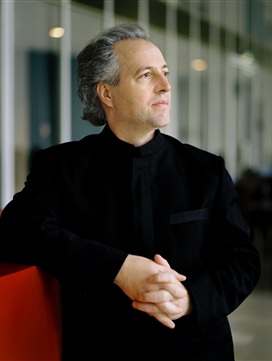Subbing for Dudamel, Honeck leads thrilling Bruckner with NY Phil
Who knows what might have been?
Gustavo Dudamel was originally scheduled to conduct the New York Philharmonic in the program that opened Thursday night at Avery Fisher Hall: an intriguing and ambitious pairing of Bruckner’s Symphony No. 9 and Claude Vivier’s Orion. But Dudamel came down with a severe case of the flu, and Pittsburgh Symphony Orchestra music director Manfred Honeck was enlisted as an emergency substitute.
Dudamel is at the preliminary stages of bringing Vivier’s sub rosa reputation to more public prominence. Before he was murdered at age 34, Vivier had written around fifty substantial pieces. He had fully emerged as a mature composer, his music synthesizing important influences like Messiaen, Stockhausen, traditional Asian music, and the spectral harmonies pioneered by Gérard Grisey and Tristan Murail, into a colorful, poetic and harmonically rich style that carried an intense sense of introspection. An orphan from birth, he seemed to be inventing his own mythology through music. Vivier’s musical language is within the bounds of the classical tradition, but off-center enough to demand acclimation from the musicians.
It was clear that Honeck did not have sufficient time to fully prepare the score and share that understanding with the musicians. The orchestral blend was rough, and the violins in particular seemed to be thinking their way through the music, counting from note to note and measure to measure rather than playing through the phrase—for example, Vivier’s predominant effect of free tremolos sounded confused.
But there are powerful ideas in Orion and, at the halfway mark, the musicians found their focus. In a small miracle of stillness and clarity, the dense textures fall away, leaving a gossamer thread of an open E-flat chord in the cellos and an arch of harmonics in the basses. Above this, the trombone plays a solo around a handful of notes, articulating muted sustained pitches, wah-wah style. The horns join in, playing sustained harmonics that dissolve into downward, vocalized glissandos.
The combination of uncommon sounds is hypnotic and stunning, and the musicians played the music with an epiphany of understanding and sympathy. From that point on, Orion was dazzling. Honeck wrapped it up with a hand gesture that seemed equal parts relief and satisfied bemusement that they had found their way through.
The concert continued, without intermission, with a thrilling performance of Bruckner’s extraordinary symphony, the playing alternating between splendor and savagery. Amidst the interpretive and emotional depths and riches of the score, Honeck showed clear and thoughtful ideas.
Bruckner’s episodic, repetitive structures still sound newer than most “New Music,” while his sensibility is not only romantic but part of a tradition of Catholic thinking that goes back to Thomas Aquinas and St. John of the Cross.
In the first movement, Honeck eschewed superficial transitional tissue and instead subtly but clearly rounded off each grand section. The payoff came in the coda, where all the previous musical events elide together as pieces of a spine-tingling, immensely powerful summation.
The Philharmonic played with tremendous relish, producing a magnificent body of sound, uncannily emulating the sensation of hearing one of the grand church organs Bruckner himself played. Even inside the enveloping sonics, Honeck revealed key details of the orchestration, moments where a bassoon or trumpet added color to the counterpoint.
The scherzo alternated between jaw-dropping malevolence and an almost ridiculously fleet-footed Trio section. The strings and horns played with such furious marcato weight that it seemed one could hold the music in one’s hands, like a substance. The horns in particular, and the Philharmonic brass overall and throughout the symphony, played with the greatest beauty of sound, power and expression imaginable.
In the finale, Honeck and musicians indulged in the sheer, involving beauty of the music. Honeck’s tempos, as in the first movement, stayed to the slower side of the road, but the pulse and forward motion never wavered. The fundamental musicality of the playing was exceptionally fine. Moments like the long, gradual crescendo towards the last great climax in the movement were intensely moving, and the musicians were clearly involved in the pleasure of Bruckner’s gorgeous harmonies.
The audience responded with a rabid ovation, and the musicians themselves honored Honeck with their own applause. Despite the unevenness of the Orion performance (likely to work itself out in subsequent repeats), Honeck did not just fill in a void on the podium—he led a performance of Bruckner’s final symphony that will linger and grow in memory.
The program will be repeated 8 p.m. Friday and Saturday. nyphil.org.







Posted Mar 29, 2014 at 11:31 pm by Dale Frehse
One of the great evenings on my 50+ years as a subscriber!